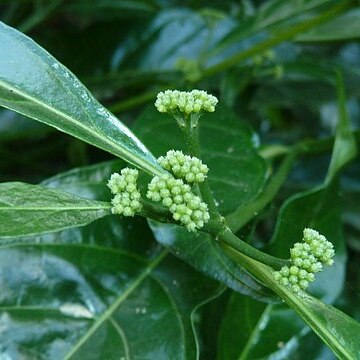Leaf blades often anisophyllous, drying black or greenish to brown, 5–20 × 2–8.8 cm, oblanceolate to obovate or sometimes broadly elliptic, acuminate or sometimes acute at apex, cuneate at base, sometimes with margins undulate, chartaceous to subcoriaceous or papery, shiny above, glabrous above or sometimes becoming pubescent towards base of midrib, glabrous to glabrescent with the nerves glabrous or glabrescent to pubescent beneath; domatia present; petiole 0.5–3 cm long, glabrous or with appressed hairs; stipule limbs with a blackened area when dry, deltoid, 2–6 mm long, gradually narrowed or with a subulate acumen 1–6 mm long, glabrous or less often with appressed hairs outside, eventually deciduous.
Inflorescences terminal on main and moderately short lateral branches, moderately lax to congested, sessile, usually with 1–3 pairs of pedunculate inflorescences arising from the next 1–2 nodes down, frequently with the supporting leaves reduced or absent, rarely with only the axillary branches present; primary inflorescence branches 0.6–2 cm long, covered with greyish to ± golden appressed hairs; pedicels 0–8 mm long, densely covered with appressed hairs; bracteoles inconspicuous, subulate to filiform.
Calyx sparsely to densely pubescent; tube 1–1.5 mm long; limb 1–2.25 mm long, wider than tube, divided for ± half its length into ovate to deltoid or oblong apiculate lobes.
Corolla white; tube 3–6.5 mm long, glabrous outside, pubescent at throat; lobes 3.5–6 × 1.5–2.5 mm, oblong, rounded, sometimes apiculate or tending to be emarginate.
Small tree or shrub, 2.75–10 m tall; young branches glabrous or with appressed hairs, older stems square, covered with buff to red-brown sometimes flaking bark.
Fruit glaucous green or white (or ?pale blue) turning black when dry, 4–8 mm in diameter, containing 2–15 seeds; calyx limb persistent.
Placenta narrowly obovate to rotund, moderately fleshy to fleshy, bearing 2–11 impressed ovules.
Seeds brown, shiny, 2.5–4 mm across, smooth.
A shrub


